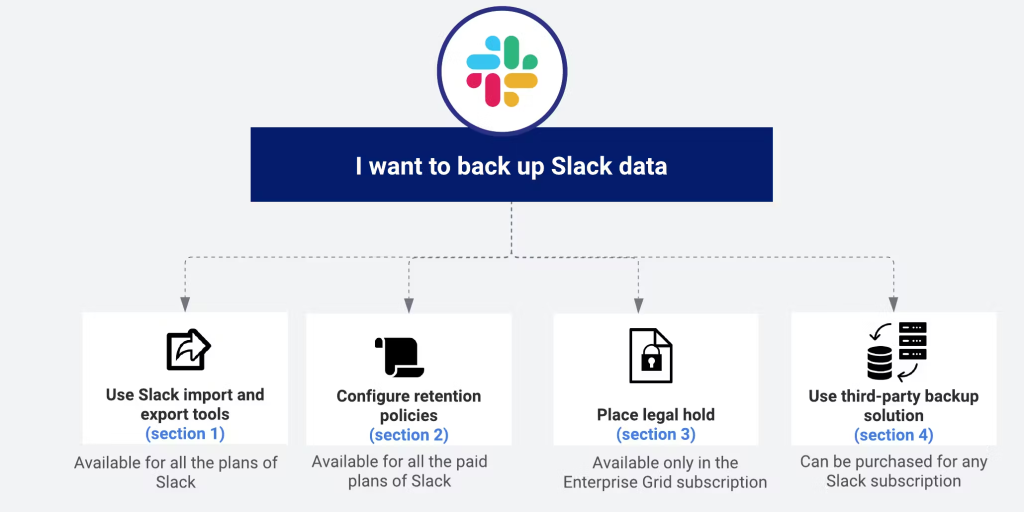Introduction:
In the digital age, businesses rely heavily on communication platforms like Slack to streamline collaboration and enhance productivity. However, with the increasing volume of data exchanged within these platforms, the need for robust backup solutions becomes paramount. Slack itself offers some basic backup features, but they may not always suffice for comprehensive data protection. This article delves into the world of Slack backup solutions, comparing commercial offerings with open-source alternatives to help you make an informed decision tailored to your organization’s needs.
Understanding the Importance of Slack Backup:
Slack serves as a central hub for team communication, storing invaluable conversations, files, and shared resources. Despite its reliability, data loss incidents can occur due to accidental deletion, malicious activities, or system failures. Without a backup strategy in place, organizations risk losing critical information, leading to disruptions in workflow, compliance issues, and compromised data integrity.
Commercial Slack Backup Solutions:
Commercial Slack backup solutions offer a range of features and benefits designed to meet the needs of businesses of all sizes. Here are some key advantages and considerations:
1. Comprehensive Backup Capabilities: Commercial solutions typically offer comprehensive backup capabilities, allowing users to back up messages, files, channels, and integrations. These backups are often automated, ensuring that no data is overlooked.
2. Ease of Use: Commercial backup tools are designed with user-friendliness in mind, featuring intuitive interfaces and simple setup processes. This makes them accessible to users with varying levels of technical expertise.
3. Advanced Security Features: Many commercial solutions prioritize data security, offering features such as encryption, role-based access control, and compliance certifications to ensure data protection and regulatory compliance.
4. Technical Support: Subscribing to a commercial backup service often comes with access to technical support from the provider, ensuring timely assistance in case of issues or inquiries.
5. Scalability: Commercial backup solutions are typically scalable, allowing organizations to adjust their backup capacity and features as their needs evolve.
Popular commercial Slack backup solutions include Spanning, Rewind, and Backupery, each offering a unique set of features and pricing options tailored to different organizational requirements.
Open Source Slack Backup Tools:
Open source Slack backup tools provide an alternative for organizations seeking cost-effective solutions with greater customization and control. While they may require more technical expertise to set up and maintain, open source tools offer several advantages:
1. Cost Savings: Open source solutions are often free to use, making them accessible to organizations with limited budgets or those prioritizing cost savings.
2. Customization: Open source tools provide flexibility for organizations to customize and extend functionality according to their specific requirements, leveraging the expertise of their internal IT teams or the open-source community.
3. Transparency and Security: The open-source nature of these tools allows for transparency in code review and community-driven security enhancements, providing assurances of data security and privacy.
4. Community Support: Open source projects benefit from a large community of developers and users who contribute to ongoing development, documentation, and support, offering valuable resources for troubleshooting and best practices.
Some notable open source Slack backup tools include Slack Backup, SlackArchive, and SlackExporter, each offering varying degrees of functionality and customization options.
Choosing the Right Solution:
When evaluating Slack backup options, it’s essential to consider factors such as the size and complexity of your organization, budget constraints, data security requirements, and technical capabilities. Here are some considerations to help guide your decision-making process:
1. Data Protection Needs: Assess your organization’s data protection needs, including the types of data to be backed up, retention policies, and compliance requirements.
2. Ease of Use vs. Customization: Determine whether your organization prioritizes ease of use and out-of-the-box functionality or requires greater customization and control offered by open source solutions.
3. Security and Compliance: Consider the security features offered by each solution, including encryption, access controls, and compliance certifications, to ensure compliance with industry regulations and data protection standards.
4. Budget and Cost Considerations: Evaluate the total cost of ownership for each solution, including subscription fees, implementation costs, and ongoing maintenance expenses, to determine the most cost-effective option for your organization.
5. Scalability and Future Growth: Anticipate future growth and scalability requirements, ensuring that the chosen solution can accommodate your organization’s evolving needs without significant disruptions or additional costs.

